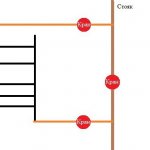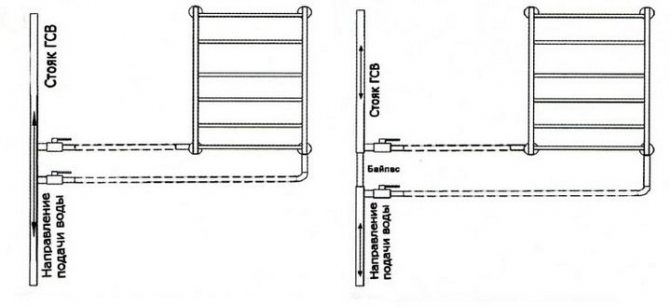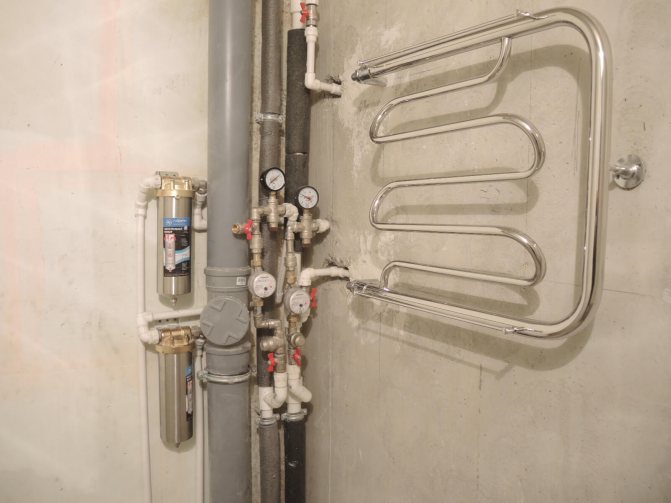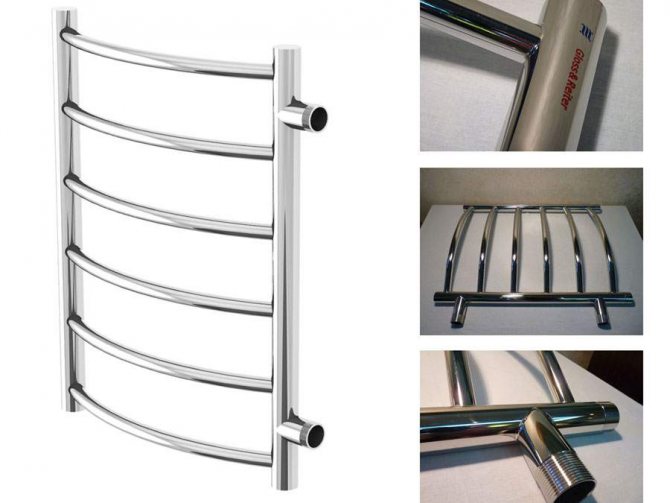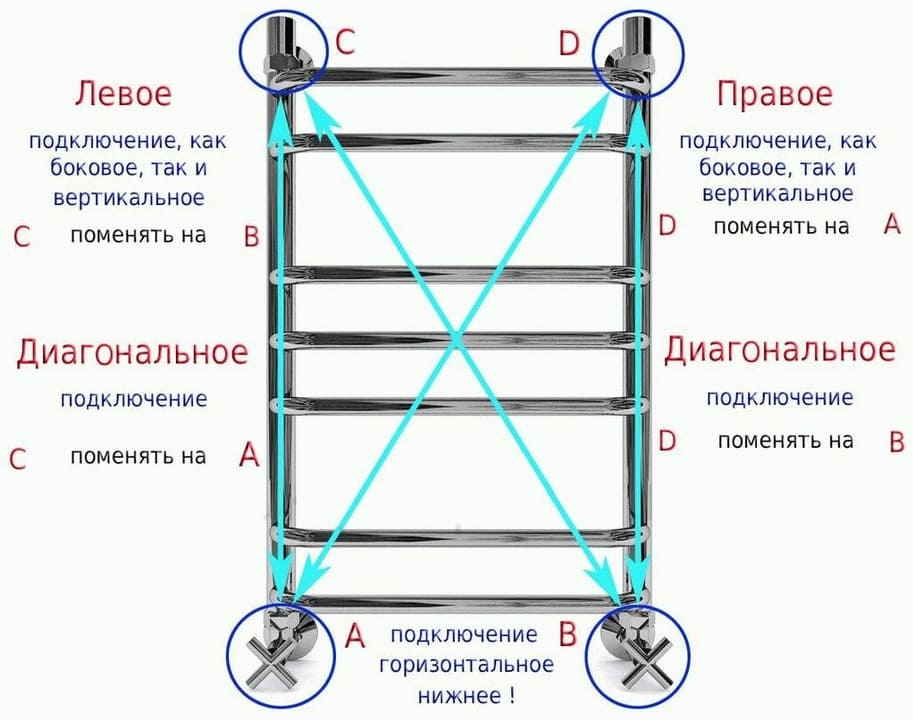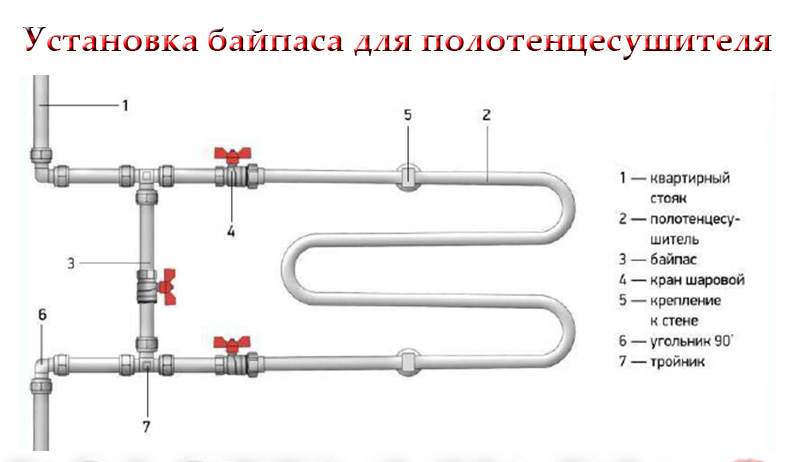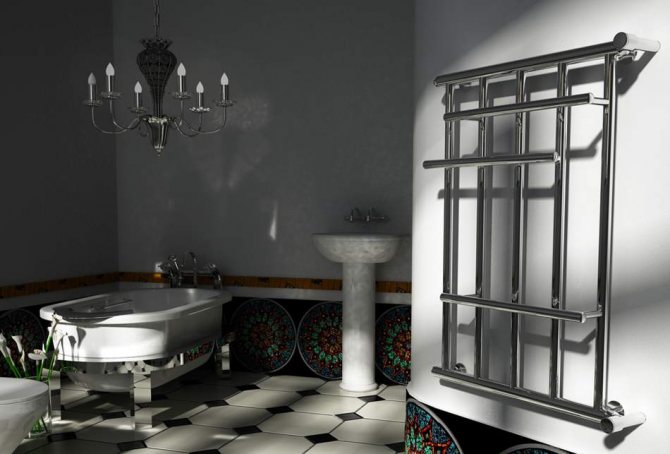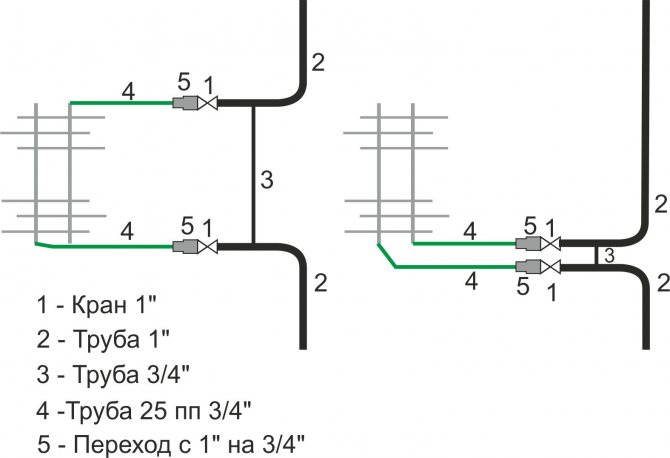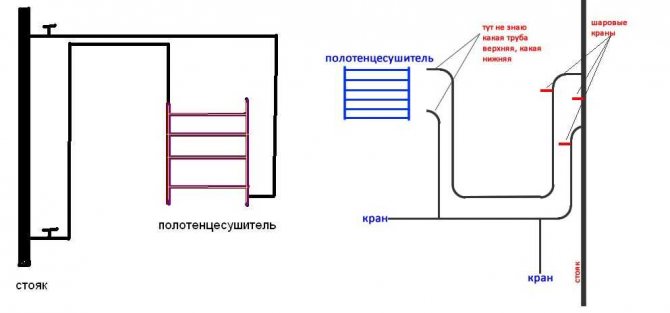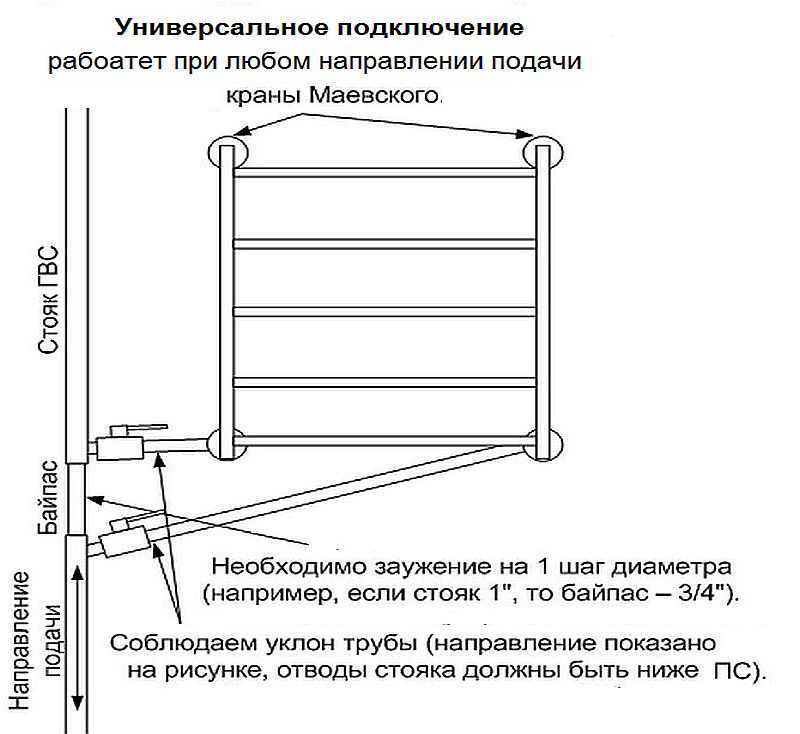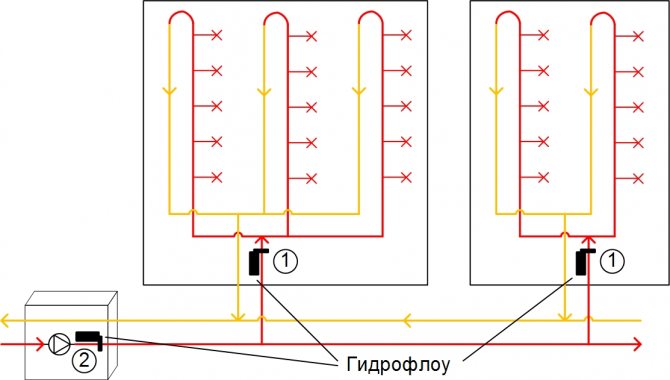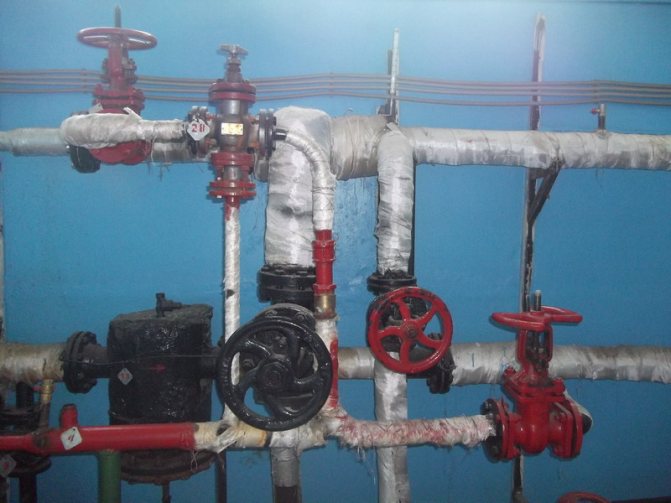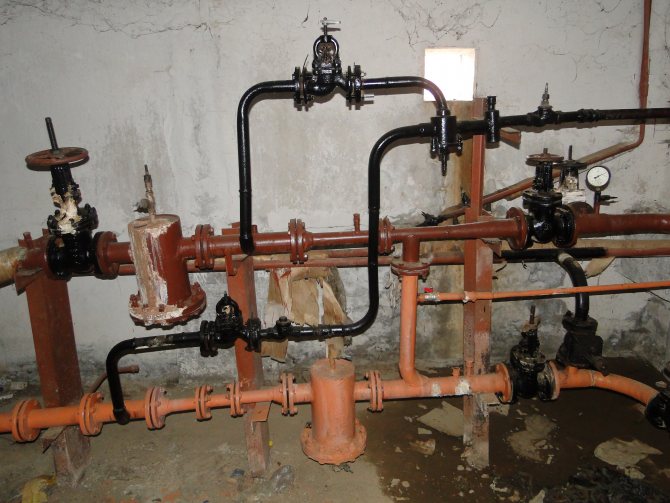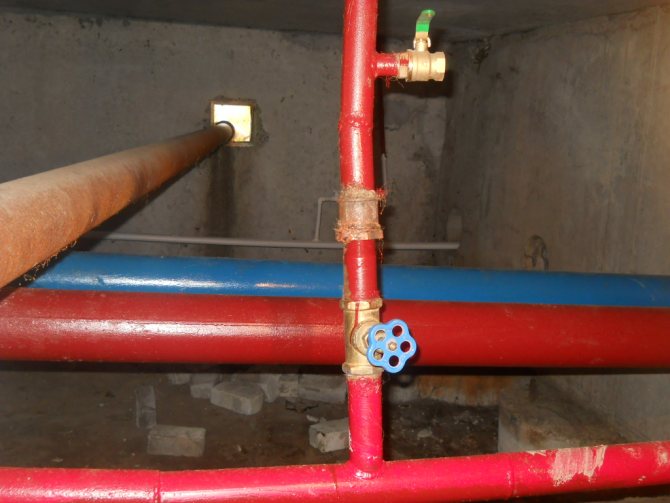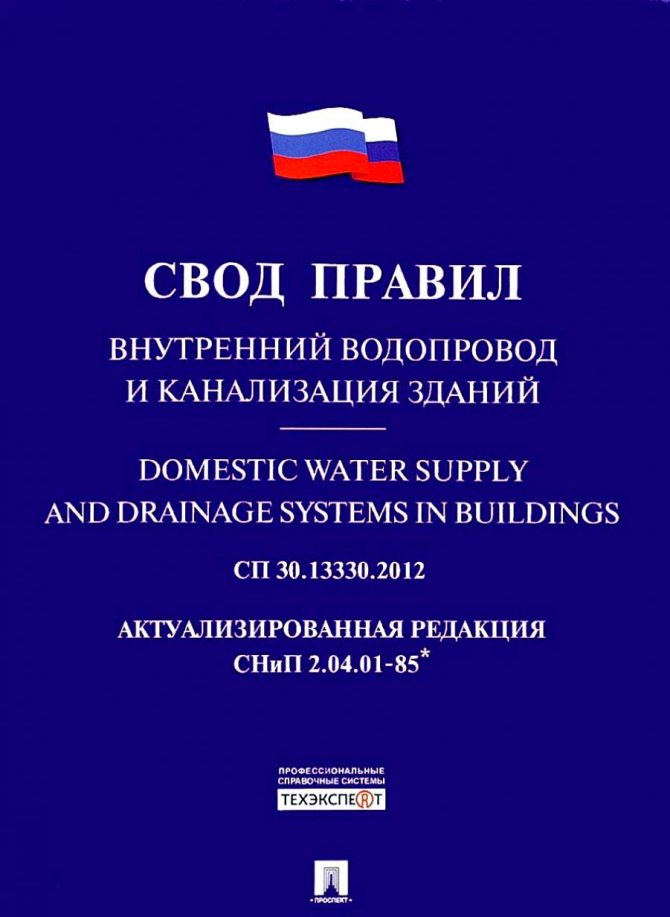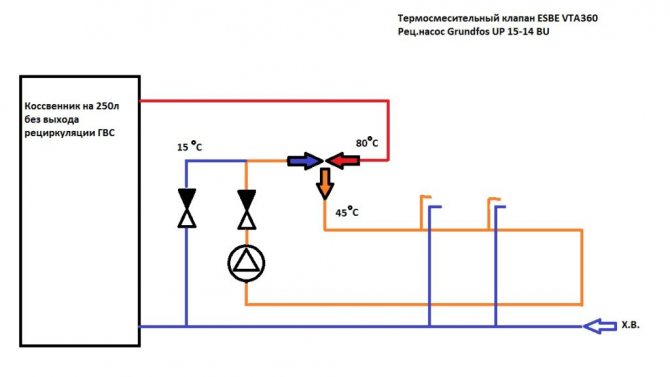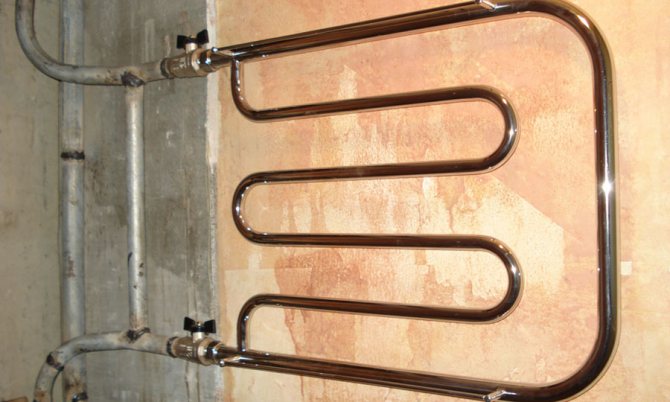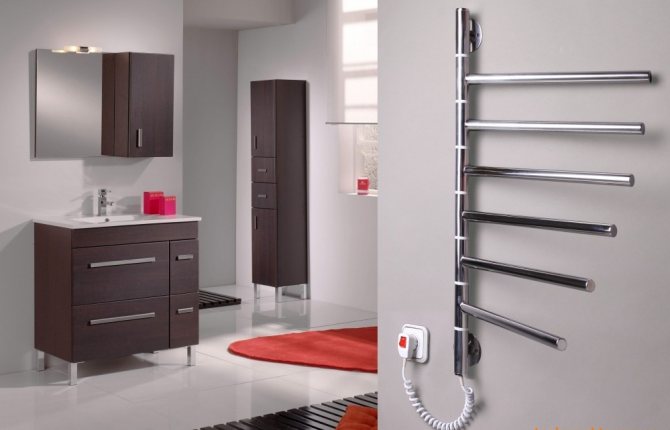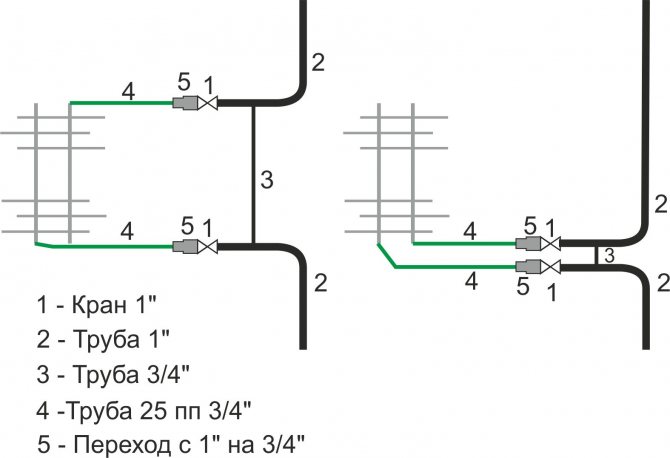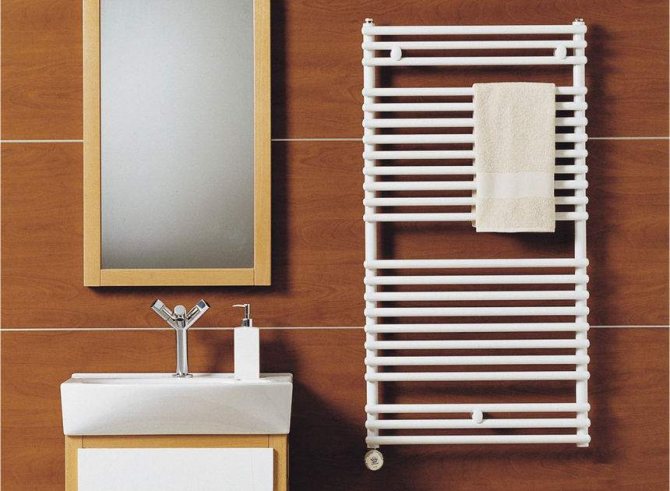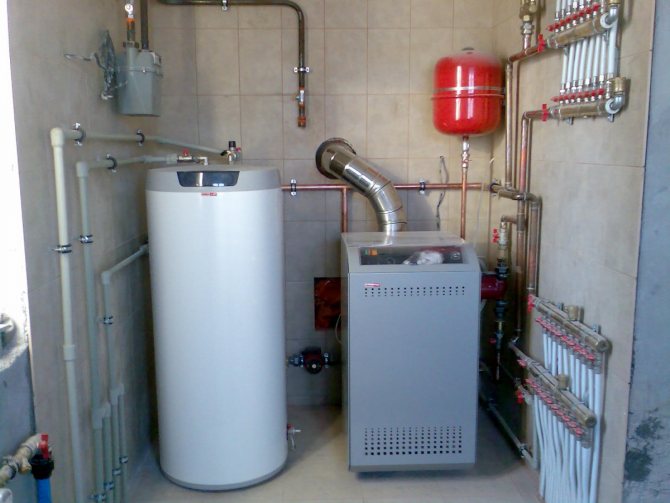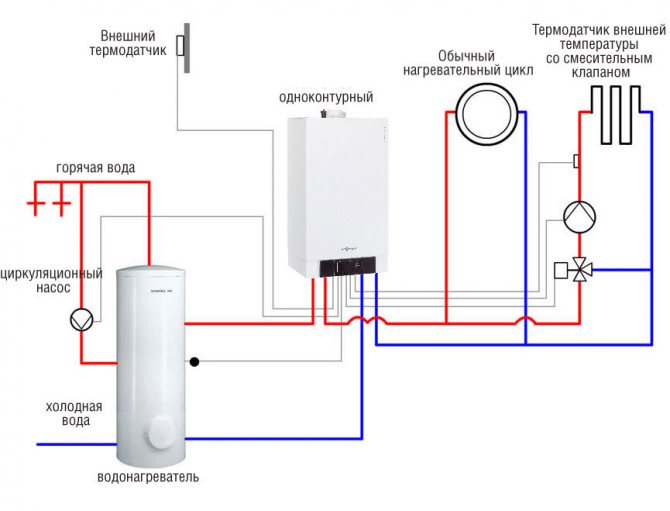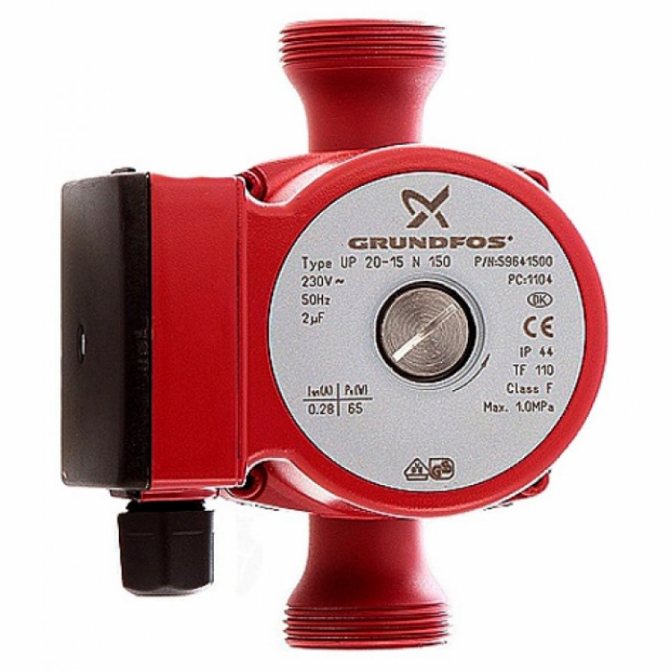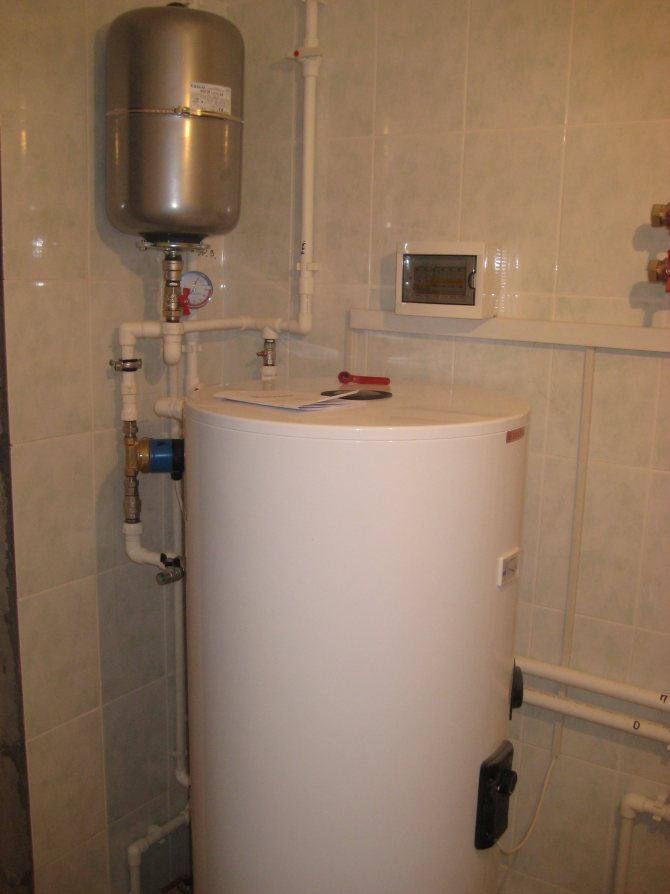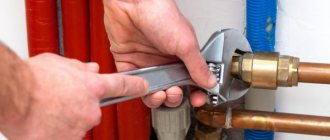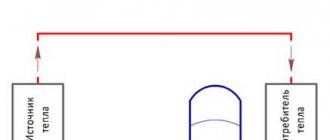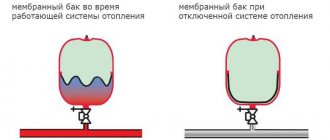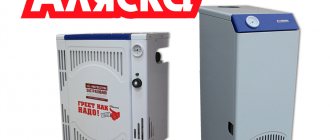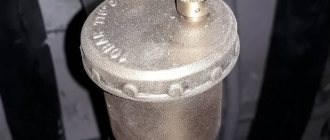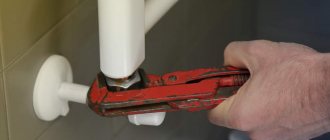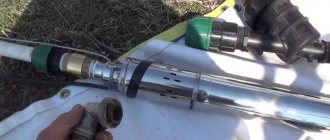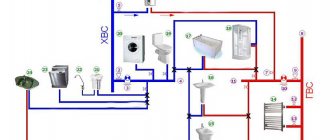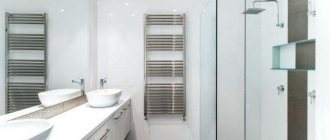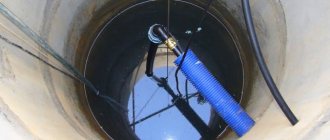A heated towel rail installed in the bathroom not only dries clothes, but also creates a favorable microclimate that prevents the formation of unpleasant odors, fungi and dampness. Today the market for this sanitary ware is full of models with various designs and functions. From this article, you will learn how to properly connect a heated towel rail to a hot water riser. A diagram and a detailed description of this plumbing equipment are also found in this publication.
Design features
The water heated towel rail can be in various configurations. The simplest among them is a coil that is connected to a common hot water supply system. Usually, this option was provided for in Soviet-built houses. In relatively new buildings, it is possible to connect a heated towel rail to a hot water riser (diagram below) via a separate outlet. This allows you to install this equipment of various modifications - from the classic U-shaped heated towel rail to the popular "ladder".
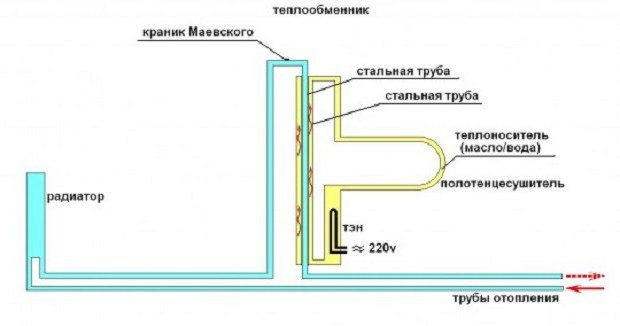
Most often, they prefer the latter option: housewives have already appreciated its convenience in everyday use and functionality. Connecting a ladder heated towel rail is carried out using the following elements:
- Water shut off valves.
- Water circulation system - supply and return pipelines.
- Blanking plug.
- Air vent valve (during installation, the Mayevsky valve is located on top).
- Bracket designed for wall mounting.
Installation procedure
The process of connecting a heated towel rail to a riser in the bathroom includes several stages of work:
- dismantling the existing heated towel rail;
- choosing a place for installing a heated towel rail with marking;
- preparation of materials and necessary tools for the installation of a hot water supply system;
- installation of two taps on the dryer;
- installation of fasteners on the wall, followed by placing a heated towel rail on it;
- jumper attachment;
- trial run of the system to identify problems.
If you decide on your own to carry out work on connecting a heated towel rail to a riser in your house, then the procedure should be as follows:
The first thing is done - an estimate of all works is made... It should include items such as:
- cost of materials and work performance;
- installation of additional screens, etc .;
- other work performed during installation.
If a centralized water supply system is installed in your apartment, then in this case it is necessary to agree with the master to shut off the water during the work. If the installation is carried out in a private house, then this is not required.
After that, the equipment is dismantled, followed by the installation of a heated towel rail
Everything ends with a connection and verification.
From the content of the process of installing a heated towel rail in your apartment, it is clear that this work is not as difficult as it might seem. After spending a few hours of your free time, you can install a heated towel rail in the bathroom with your own hands.
Aquatic
This option has been known to us since the days of the USSR, when such equipment was installed in all bathrooms. Such models remain the most popular to this day.In this case, the heated towel rail is connected to a hot water riser (the diagram will help to do this correctly) or to the heating system.
Valves are installed on the device itself, with the help of which the water is shut off when replaced. These models are generally available in stainless steel, brass and copper. And most importantly, they have a low cost.
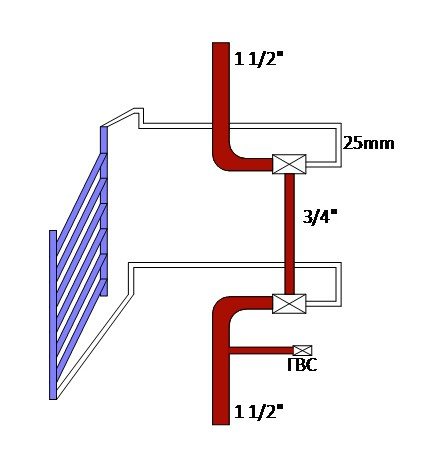

Connecting a heated towel rail: DHW or heating
Before you install a water heated towel rail in the bathroom, you need to decide on the method of connecting it.
There are two options available:
- Connection to the DHW system ... The method guarantees year-round heating. The device heats up when hot water is consumed - overnight the heated towel rail cools down even if it is directly switched on through the riser.
- Heating system insert... The option is relevant in the absence of a centralized hot water supply network. Thanks to the forced circulation of the coolant, the coil remains warm around the clock. The disadvantage is that drying functions only in the cold season.
When replacing a heated towel rail in an apartment building with a change in the method of connecting it, you will need to develop a project and approve it in housing and communal services. Registration of the package of documents will take about a month.
Electrical
This model is used if there is no possibility of connecting a water heated towel rail. There are two main options - wall-mounted and floor-mounted. The first of them has the most varied design and is used in small rooms. Having given preference to this option, special attention must be paid to the power consumption in order to calculate in advance the approximate cost of electricity. In this case, the connection diagrams for the heated towel rail may be as follows:
- Open - plug and socket are in use.
- Closed - the wiring fits into the wall structure.
The main features of electric towel warmers:
- Often these devices are equipped with temperature control.
- They can be installed not only in the bathroom, but also in other rooms.
- Thanks to a variety of design solutions, you can choose a model that fits perfectly into the design of the room.
How to arrange taps (connection methods)
With lateral and diagonal connection, the outlets should be located at the same level with the inlets of the heated towel rail or slightly above / below. What will definitely not work is installing a heated towel rail if the outlets are located at a distance less than the distance between the entrances. The photo below is an example of a non-working diagonal connection with closely spaced taps. The option to correct it (top feed) is indicated in black.
When connected to the side, the heated towel rail will only work if the outlets are slightly higher and slightly lower than its inputs, or at least at the same level
When connecting, the taps must be placed strictly horizontally or slightly at an angle. Slightly at an angle - this is from 2 cm per meter (2%) or a little more. The direction of the slope depends on the connection diagram and on which end this branch will be connected. To make it a little clearer, we will consider several typical schemes for connecting heated towel rails.
Universal bottom connection of the ladder heated towel rail
This circuit works regardless of the direction of hot water supply. Connection type - bottom, both outlets must be located lower than the bottom edge of the dryer. At the top feed, an option is acceptable when the edge is between the taps, but the work may no longer be so effective (it may heat up worse).
Universal connection of a heated towel rail (bottom)
In this scheme, shut-off valves can be installed. For its normal operation, you need:
- Mayevsky taps (air vents) installed on the upper outlets for the release of the air accumulating in the upper part. They will need to be periodically opened and the air deflated (as it starts to warm up worse). There is an option - to supply automatic air vents. They are also compact. This will simplify operation.
- Straight bypass with constriction. The size of the constriction is with the pipe one step smaller in diameter.
- Bends are made with a pipe at a step smaller in diameter than the main riser.
If you have this option in height, do it. The scheme works in any conditions, with any kind of ladder-type heated towel rails.
Possible bottom connection for top supply
When pouring hot water from above, the upper outlet can be made higher than the lower edge of the dryer. With an offset bypass and its narrowing, it should warm up normally. This method is not the best, but it works.
Working version with top pouring hot water
The presence of air vents and air bleeding after stopping the system are mandatory.
Universal side connection
You can bring the pipes from the side to the heated towel rail of any of the standard shapes - U-shaped, snake and ladder. The connection itself does not depend on the form. The standard version comes with a straight, unrestricted bypass. Elbows are either strictly horizontal or with a slight slope. The slope is shown in the figure: the end of the upper branch is inclined slightly downward (2 cm by 1 meter), the lower one is lifted slightly upward. The diameter of the bends is not less than the diameter of the heated towel rail.
Side universal connection of a heated towel rail
Such a connection scheme is good in that it is not necessary to install air vents on the "ladder" (they put plugs), since the air simply goes into the riser.
With the top supply on the bypass, you can make a narrowing and / or move the jumper towards the heated towel rail. This will improve circulation and the dryer will heat better. But again: such a scheme will only work with the upper water supply.
When water is supplied from above, the bypass can be displaced and made into a pipe by a step of a smaller diameter
With this scheme, you can also make bends at a slight slope or strictly horizontally.
Possible side connection option (not the best)
A side connection scheme with the location of the upper outlet below the upper edge of the heated towel rail is acceptable. But with such a connection, Mayevsky taps are needed, through which you will have to bleed air after turning off the hot water supply for repair / maintenance. Periodic bleeding may also be required during the process.
Not the best, but quite workable option
Diagonal connection
There is no special sense in the diagonal connection of most heated towel rails: their efficiency is no different from the lateral one (in any case, there is no significant improvement), and the pipe flow is larger, and the grooves are required longer, and this is laborious. Although the circuit is functional.
The diagonal works fine if the water supply is from the top. Then the upper branch is connected to the far edge of the "ladder", and the lower one - to the near one.
Diagonal connection at top feed
In this case, you can also make a narrowed and offset bypass, but even without this, everything should work "with a bang." At the bottom supply, the bypass without constriction, exactly along the riser, connection
Heated towel rails of complex shape: how to connect
In the case of connecting heated towel rails of complex shape, in addition to the usual means, one also has to take into account the structural features of each specific model. They must be considered from the point of view of hydrodynamics - where the water will flow better, there and supply water. For example, the popular model "Elegy" by Sunerzha. This is not a ladder or a zig-zag.
A diagonal connection was chosen here, because the other simply will not work
Installation of the Sunerzhi Elegy heated towel rail was chosen lateral, since any other circulation will be disturbed. There are no options at all.
Another model with bottom connection and a complex design has three installation options. Provided that water is supplied from above, the second will work best, the first will work a little worse, the third will be the least effective.
Bottom connection options with top spillage
When feeding from below, options 1 and 3 remain, but only without narrowing the bypasses - it will interfere, not help. We completely exclude the second option.
Dismantling of modern construction
If modern equipment has been correctly installed, with detachable connections, it will be easy to replace it. It is important that the new plumbing device is similar to the old one and has the same dimensions in the centers of the connecting pipes.
The new equipment must be aligned with the center of the connections. It is necessary to remove the heated towel rail, which has already served its purpose, and then install a new one on the mating connectors, connect it to the system and fix it on the wall.
Varieties of towel warmer designs
The market offers several forms of heated towel rails, which differ in the way of heating:
- electric - autonomous heaters in the form of a heated towel rail, which operate from the electrical network;
- combined - autonomous, operating on a water heating element;
- water - connected to the heating system or hot water supply.
The first two types of heated towel rails are sold ready-to-use. To install them, you will need the brackets that come with the kit. The third type, the water type, requires the use of additional parts not only for fixing on the wall, but also for connecting to the water supply system.
Note! A water heated towel rail is the most common type and the most economical. After installation, it does not require additional costs, since it is integrated into the central communications.
Water heated towel rails can have different geometric shapes:
- classic coil;
- U-shaped;
- in the form of a ladder of different sizes;
- angular.
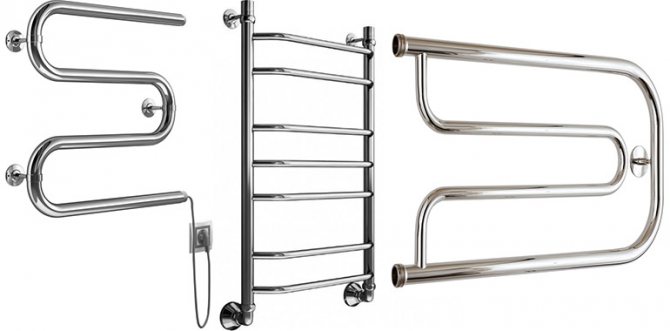

The shape of the heated towel rail does not affect the connection to central communications and is a matter of taste for the owner.
Metal for a heated towel rail is different. Since it has constant contact with moisture and heat, it must be a corrosion-resistant metal.
Manufacturers offer the following options:
- stainless steel;
- copper;
- chrome steel;
- brass.
All of the listed metals and alloys are corrosion resistant and have an attractive appearance.
Note! In addition to beauty and price, the main criterion when choosing a heated towel rail should be its diameter and the compatibility of imported models with domestic threads on fittings.
The diameter of the heated towel rail must match the diameter of the heating pipe (or hot water supply) to which it will be connected. The most common options are: 32 mm or inch; 25 mm or ¾ in. If the coil is smaller than the central pipe, it can burst due to a pressure surge in the system.
We recommend that you familiarize yourself with: How to independently install plastic pipes
Removing the old coil
It is much more difficult to replace the old Soviet coil. In this case, a side-connected heated towel rail is installed together with the replacement of the riser. Moreover, it can be partial (in your apartment) or complete. However, it is impractical to change part of the old pipeline; it is advisable to completely replace the riser. To do this, you will need to negotiate with the neighbors from below and from above, so that they connect a new riser. This is a common practice as it is very dangerous to leave old pipes in the ceiling.
Dismantling
Situations are quite common when, even before connecting a new heated towel rail, you have to remove old products. For such cases, the following connection schemes for a heated towel rail of old modifications have become widespread:
- for modern devices;
- for old-style coils.
Dismantling of modern construction
If the bathroom has a modern model of a heated towel rail, installed in compliance with all requirements and having detachable connections, then when performing work on its dismantling, difficulties should not arise. Special attention should be paid here to ensure that the design of the installed sanitary ware coincides with the old model, and the dimensions in the centers of the connecting pipes are identical.
Make sure that the center of the connecting pipes is on the product in the same place as the heated towel rail to be removed. After removing the old product, it is necessary to install a new one by attaching it to the mating connectors of the connectors, after which they proceed to connect it to the system and fix it on the wall.
Removing the old coil
Much more difficulty will arise if you have to deal with the old Soviet coil. With this option, the installation diagram of a heated towel rail with side connection requires its installation simultaneously with the riser... It is noteworthy that this element can be replaced in whole or in part. Moreover, replacing only part of the old pipeline does not seem to be the best solution, therefore it is most correct to install a new riser. To implement such an idea, you will have to get the consent of the neighbors from below and from above, so that you can connect a new riser to them. Such situations are quite common, as the owners realize how much of a threat the old pipes in the ceiling pose.
Jumper installation
The jumper is a kind of lifesaver in unforeseen situations. Its installation is optional, but highly desirable. So, for example, a leak has formed at the junction of a heated towel rail, which becomes more and more intense every minute. And there is absolutely no time to call the emergency services and wait more than an hour for their arrival.
So, in order not to depend on such situations, a bypass is installed. Outwardly, it is an ordinary section of the pipeline. To install it, ordinary ball valves are mounted on the ends of the heated towel rail, with which you can shut off the water flow if necessary.
Water heated towel rail: side connection
This design option allows you to install plumbing equipment in a standard towel rail riser or in an existing hot water network. In other words, it does not require the preparation of an additional drainage system. However, water heated towel rails with side connection have one small drawback - the presence of welded elements. But with the proper quality of plumbing equipment, this model will last a long time.
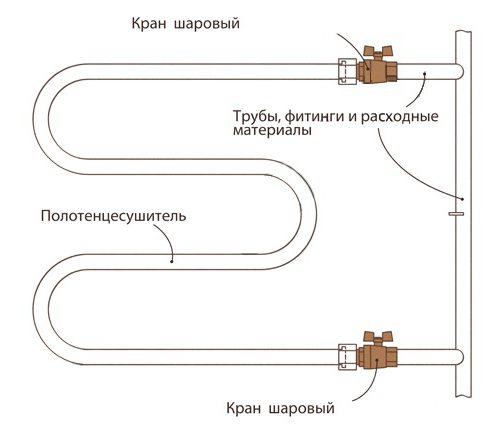

When connecting this device, the following parameters must be taken into account:
- Correspondence of pipeline diameters.
- Center distance - the distance between the outlet and inlet holes.
It is allowed to carry out the side connection of the "ladder" heated towel rail with the use of water pipe couplings. At the same time, it is forbidden to make the transition from pipelines with a large diameter to pipes with a smaller section, as this can lead to an increase in pressure in the device, which will provoke leaks or even rupture of welded joints.
In addition, water heated towel rails with side connection are installed in situations when it is planned to close the water pipes by means of tiles. During the installation process, it is necessary to ensure reliable waterproofing of the pipeline and the connected device.For this, gaskets and couplings are used, which are pulled together using an adjustable wrench of the appropriate diameter.
When installing a side-connected heated towel rail, it is important to remember that the water supply is carried out under pressure, respectively, the connection points must withstand sudden changes and a strong pressure of the water supply.
Installing a water heated towel rail with your own hands
To install a new device, first of all, a heated towel rail connection diagram is required, indicating the size of each section and the location of the fittings, then the assembly will turn out to be more accurate.
Do-it-yourself installation of a heated towel rail in the bathroom now requires a soldering iron for welding plastic pipes. The set should include nozzles of standard sizes. If you follow all the instructions correctly, the welding process is easy to master on your own. It is helpful to watch a video tutorial on this topic so you don't miss out on important technology points.
USEFUL INFORMATION: Bathroom with a window: design, 15 photos
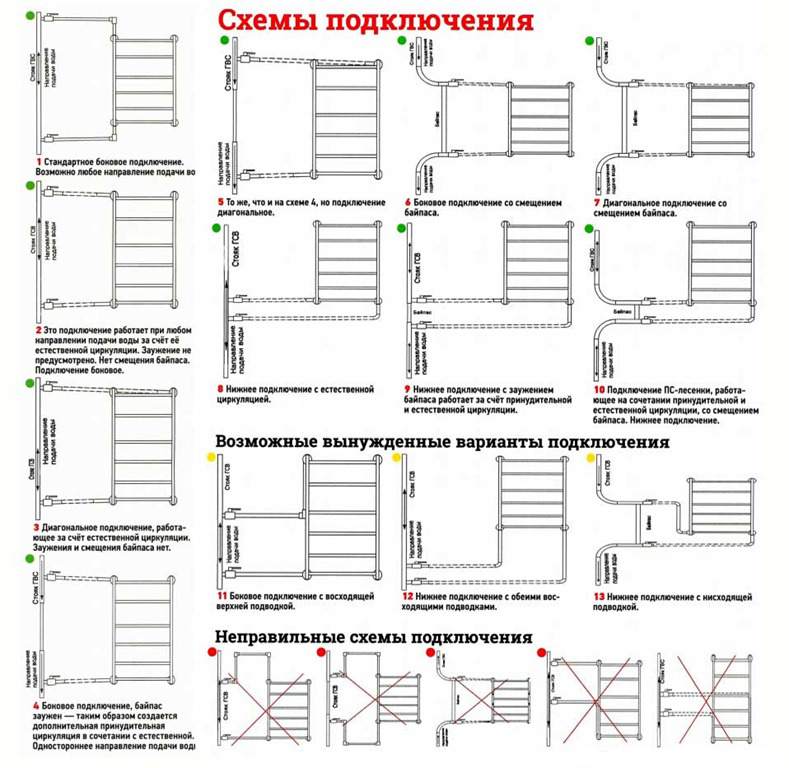

You can extend the pipes to any place where the device will be installed. Don't just hang a heated towel rail over the bathroom. There are several reasons for this:
- Dryers are never placed where there is excess moisture.
- The ingress of water on hot pipes will provoke increased humidity and the settling of calcium salts on them.
- It is inconvenient to take a shower and reach for things on pipes through the bath.
Pipe preparation
The work progress will be as follows:
- A pipe cutter is used to cut sections of plastic pipes of the required size. At the ends, a chamfer is removed with a slope of 150 and a length of 2-3 mm. Burrs and crumbs are removed from cut edges for quality joints.
- It is necessary to turn off the valve for supplying hot water to the riser and cut off the old heated towel rail from the pipes.
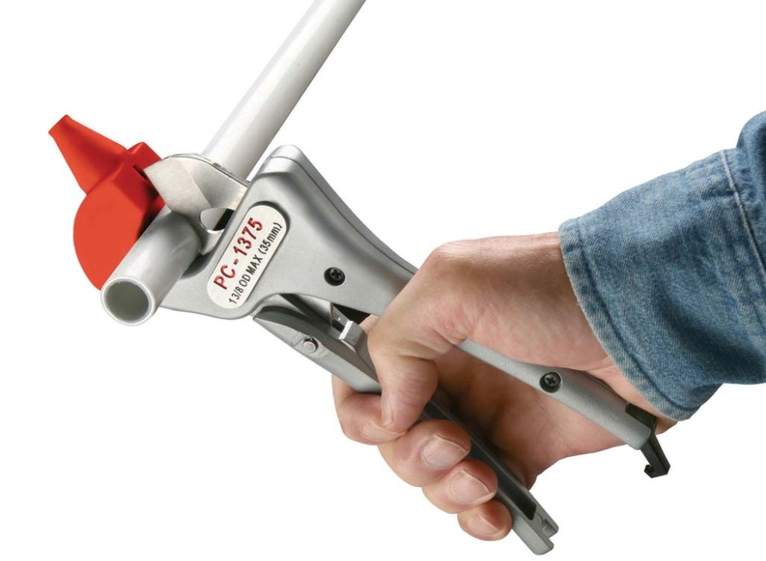

Important! The issue of installing the device should be previously agreed with the ZhEK.
- The riser can be worn out, then it is advisable to replace it in part or put a new one entirely. It is advisable not to leave old pipes in the ceilings, and the connection points for new ones should be available for repair. The work of replacing the riser and installing branches from it should be entrusted to specialists.
- The next step is to install ball valves and a bypass - a section of the pipeline with fittings.
Attaching the heated towel rail to the wall
How to hang a heated towel rail in the bathroom? For this, brackets are used. First, they are screwed to the device, then they are leveled with a level and marks are made on the wall.
In the bathroom, you have to drill holes in the tiles, for which a special drill is used. The device should be fixed to the wall with plastic dowels.
It is important to decide at what height to hang the heated towel rail, and choose the right gap. The distance from the wall to the axis of the heated towel rail pipe according to the norm is:
- from 5 to 5.5 cm with a diameter of up to 2 ″;
- 3.5 cm in diameter up to 1 ″.
The mount can be fixed or with an adjustable clearance due to a stud screwed into the bracket. In this way, the necessary air circulation can be created to ensure quick drying of the laundry. Too frequent adjustments are not recommended as the pipes are constantly under pressure. They work reliably when they are permanently fixed.
The device should not be rigidly fixed so that the load-bearing sections of the wall are not loaded during thermal deformations of the pipes.
How to install a heated towel rail for ease of use? The standard provides that the installation height of a heated towel rail according to the rules is 120 cm.If the size cannot be maintained, the permissible lower limit is 95 cm, and the upper limit is 170 cm.
USEFUL INFORMATION: Installing a thermostat on a radiator
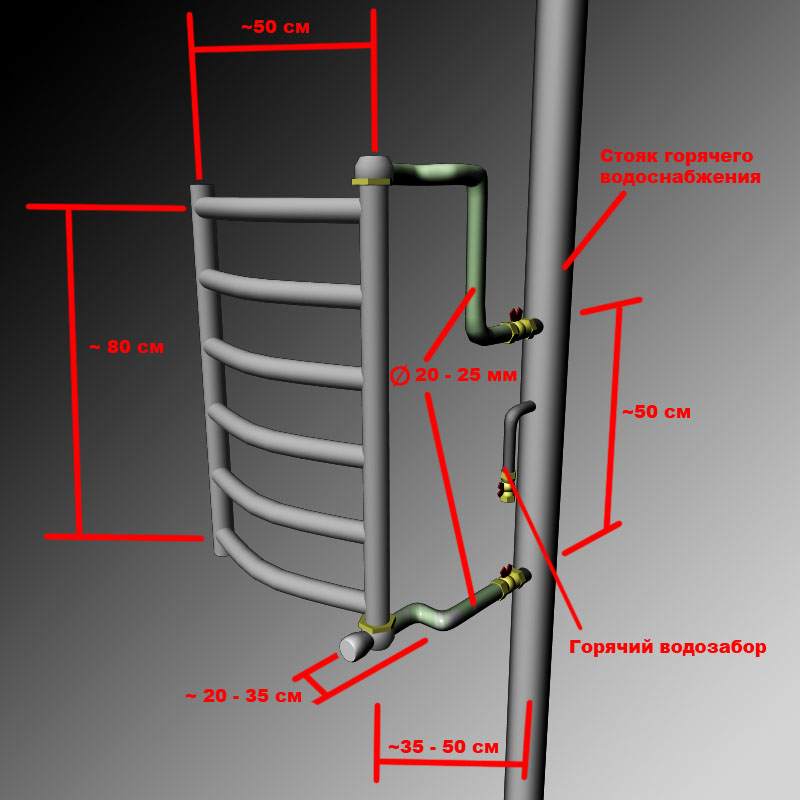

Before connecting the heated towel rail correctly, you should select the appropriate fittings.The thread is sealed by winding from flax, and the tightening is done carefully so as not to damage the threaded connections.
Pipe connection
Polypropylene pipes are welded to the couplings with a soldering iron. Nozzles of the required length are cut. The ends are chamfered and the edges are cleaned. The pipe is inserted into the sleeve, and the sleeve is pushed onto the pin, after which they are heated. The warm-up time is determined from the table.
Additional control: an element is considered hot if it can be easily rotated and removed from the nozzle.
After removing from the soldering iron, the heated parts are immediately connected. They are positioned exactly relative to each other with slight pressure. After 3-5 seconds, the pipe joint sets.
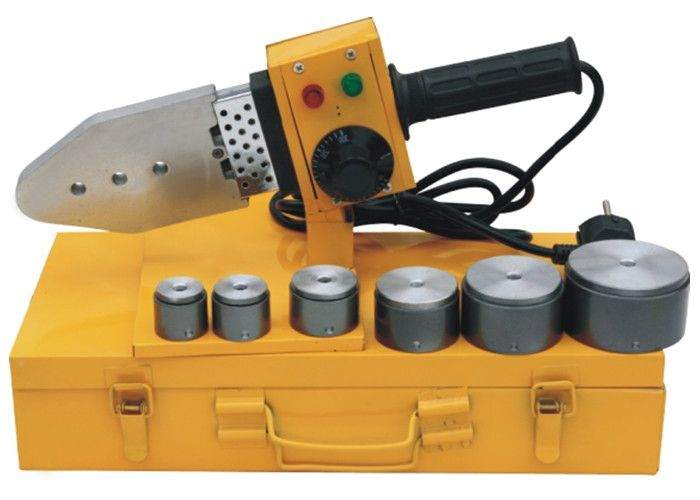

Install the device so that water flows through it from top to bottom. For this, a water heated towel rail is first connected to the riser with the upper inlet socket. Having connected and secured the device, the system is checked for leaks, for which they open the taps and turn on the supply of hot water. The installed devices must be free of leaks.
How do I connect correctly?
The equipment must be installed in the bathroom in accordance with accepted standards. Thus, the connection diagram of the heated towel rail to the hot water supply riser must meet the requirements of SNiP 2-04-01-85. A similar design is connected to the heating system in private houses that are equipped with an individual heating system.
In multi-apartment buildings, it is more expedient to carry out installation in full accordance with the project, if necessary - to a separate riser. This approach is quite justified, because the central heating system functions only in the cold season, and the water supply is carried out constantly.
The principle of connection is not affected by the type of heated towel rail: it is important to correctly ensure the supply and outflow. As a result, a regular water supply will be produced. Depending on the design features, the following connection methods are possible:
- Top-connected device.
- Heated towel rail with bottom connection.
- At the bottom of the plumbing fixture.
- Diagonal connection (used for ladders).
Thus, the connection diagram of the heated towel rail to the riser directly depends on the installation conditions and the type of structures.
Heated towel rail connection diagram
In order to connect this equipment to a riser in your house, you need to have an idea of \ u200b \ u200bthe scheme for its installation. It is simple and everyone can master it. If hot water acts as a coolant that will circulate through the system, then the installation of this equipment can be carried out in a hot water supply pipe. Or you can install a home heating system. In the bathroom, it is best to connect the heated towel rail to the hot water supply system, which will provide heating of the room due to the coolant circulating in the heated towel rail.
Works when connected
The connection diagram for a water heated towel rail assumes the work in the following order:
The first thing that is done is the installation location is determined. In this case, it is necessary to decide what type of connection in your room will be the most optimal.
When the issue is resolved, you can proceed to connecting special couplings. At the moment, in stores you can buy couplings of the following sizes: 1 * 1/2, 1 * 3/4, ¾, ¾ * 1/2.
When choosing them, one should proceed from what types of outputs are available on the heated towel rail you purchased.
The connection of water devices is carried out along the course of the coolant, with a slope, the value of which can vary from 5 to 10 mm along the length of the liner... With the length of the latter up to 500 mm, you can use the horizontal installation option.
If we talk about the most optimal installation option for this equipment, then this is the case when water is supplied from top to bottom. This allows you to achieve correct water circulation in the equipment and ensure the efficiency of the system as a whole.
When installing a heated towel rail in an apartment, it is necessary to maintain the correct distance from the pipe to the wall surface. It is in many ways depends on the diameter supply pipeline:
- if the pipe diameter varies from 40 to 50 m, then a distance of 55 cm will be optimal;
- with a pipe diameter of up to 23 mm, the distance to the wall must be at least 35 mm.
Special stops - it is on them that the water heated towel rail will be suspended. Do not weld equipment to supports. Its attachment must be free. This eliminates the risk of thermal deformations. Be aware that they pose a serious hazard to hot piping.
After the equipment is connected in the hot water supply system, a check of its operability should be performed. You should also make sure that all joints are tight. Leaks, water droplets, etc. should not be observed.
As you can see, the connection diagram for a heated towel rail in a private house is not that complicated. In order to carry out the installation of this equipment with high quality, it is necessary when carrying out work comply with all normswithout forgetting the manufacturer's recommendations. Poor quality materials should not be used during installation work, as this can lead to leaks during operation, which will lead to a lot of unpleasant moments.
If you doubt that you can carry out the installation of a heated towel rail on your own, then in this case it is better not to risk it, but to turn to a professional who will install the necessary equipment in the bathroom in a short time.
Highlights
To connect any equipment in the bathroom, you need to have professional skills. Since errors in measurements of a few millimeters can lead to big troubles and problems with operation. If there is a need to install a heated towel rail, you should contact an experienced specialist.
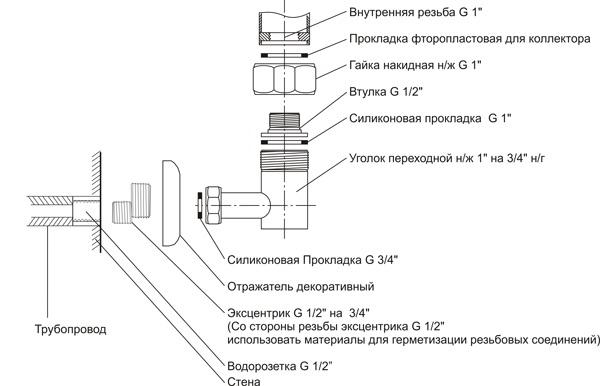

It is important to take into account the peculiarities and subtleties of the work:
- Making accurate measurements.
- Determination of the location of the structure.
- The presence of couplings, fittings, brackets and other additional parts.
- Choosing a connection method.
Installing a heated towel rail in the bathroom belongs to the category of difficult plumbing work. Therefore, if you are not sure, you do not need to tempt fate and try to complete the installation yourself. The consequences can be very different: from banal leaks of pipelines covered with ceramic tiles, to damage to tiles in the process of hanging brackets.
Before starting work, it is important to decide whether such work is within your power or not. Even if you decide not to do it yourself, at least you will know the installation sequence, which will allow you to control the quality of the installation of the hired specialists.
Hiring professionals is the most correct and balanced decision, thus, you will be able not only to save time and nerves, but also to get an excellent result. Quick drying will become a pleasant reality, towels will be fresh and dry, and the bathroom will be comfortable.
Feature of chrome parts
Chromium plating of metal parts is carried out by applying a thin layer of chromium to the surface. This layer protects the base metal from damage.
Chromium plating has several goals:
- Improving appearance. Chrome plating of fittings transfers the connecting piece from the category of plumbing to the category of interior, design.
- Hide metal defects.
- Improve performance properties.
- Extend the life of the fittings.
The chrome surfaces give the bathroom a special atmosphere of crystal clear luxury. Their mirror-like shine, perfectly flat surfaces are in harmony with tiles and sanitary ware, organically fit into the room.
We recommend that you familiarize yourself with: Using copper pipes in various pipeline systems - pros and cons

